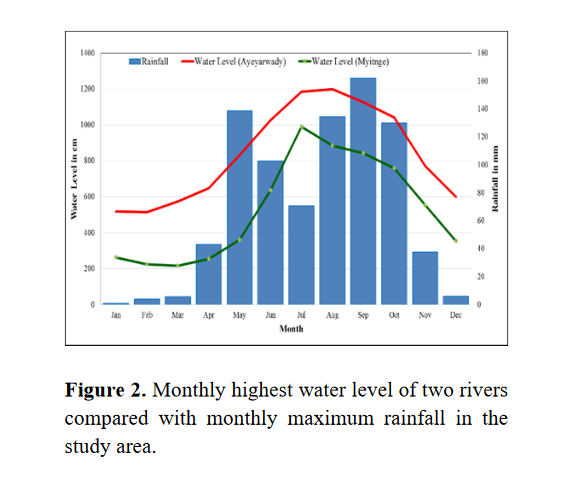Flood Hazard Mapping using Hydraulic Model and GIS: A Case Study in Mandalay City, Myanmar
Keywords:
Flood frequency, HEC-RAS, Flood hazard, Return period, GIS.Abstract
This paper presents the use of flood frequency analysis integrating with 1D Hydraulic model (HEC-RAS) and Geographic Information System (GIS) to prepare flood hazard maps of different return periods in Ayeyarwady River at Mandalay City in Myanmar. Gumbel’s distribution was used to calculate the flood peak of different return periods, namely, 10 years, 20 years, 50 years, and 100 years. The flood peak from frequency analysis were input into HEC-RAS model to find the corresponding flood level and extents in the study area.
The model results were used in integrating with ArcGIS to generate flood plain maps. Flood depths and extents have been identified through flood plain maps. Analysis of 100 years return period flood plain map indicated that 157.88 km2 with the percentage of 17.54% is likely to be inundated. The predicted flood depth ranges varies from greater than 0 to 24 m in the flood plains and on the river. The range between 3 to 5 m were identified in the urban area of Chanayetharzan, Patheingyi, and Amarapua Townships. The highest inundated area was 85 km2 in the Amarapura Township.
References
Aye Ko, U. (2006). Flood Forecasting and Mitigation in Myanmar, Department of Meteorology and Hydrology, Ministry of
Transport, Myanmar.
Brunner, G., & Bonner, V. (2010). HEC River Analysis System (HEC-RAS), Hydraulic Reference Manual. Version 4.1. January 2010.
CA: Hydrologic Engineering Center.
Department of Meteorology and Hydrology, Ministry of Transport. (2004). DMH Annual Flood Report. Myanmar.
Department of Meteorology and Hydrology, Ministry of Transport. (2006). DMH Annual Flood Report. Myanmar.
Department of Meteorology and Hydrology, Ministry of Transport. (2010). DMH Annual Flood Report. Myanmar.
Department of Meteorology and Hydrology, Ministry of Transport. (2011). DMH Annual Flood Report. Myanmar.
Khattak, M. S., Anwar, F., Saeed, T. U. Sharif, M., Sheraz, K., & Ahmed, A. (2016). Floodplain mapping using HEC-RAS and ArcGIS: A case
study of Kabul River. Arabian Journal for Science and Engineering, 41(4), 1375–1390.
Sein, K. K. (2012). Geospatial Analysis of Climate Change Impacts on Flood Frequency and Flood Risk in Mandalay. (Master Thesis,
Asian Institute of Technology).Subramanya, K. (2006). Engineering Hydrology, (2 nd ed.). New Delhi, Tata McGraw-Hill.
Tate, E., & Maidment, D. (1999). Floodplain mapping using HEC-RAS and ArcView GIS. Retrieved September 10, 2015, from
http://www.irfaNakar.com/gis_remote_sensing_files/HECRA-S/Floodplain Mapping Using HEC-RAS and ArcView GIS.pdf
Union of Myanmar (Department of Meteorology and Hydrology (DMH), Forest Department, Relief and Resettlement Department, Irrigation Department and Fire Services Department), Myanmar Engineering Society (MES), Myanmar Geosciences Society (MGS), Myanmar Information Management Unit (MIMU) and Asian Disaster Preparedness Center (ADPC).(2009). Hazard profile of Myanmar. Retrieved from http://www.preventionweb.net/files/14567_14567HazardReport25.8.091.pdf.
United Nations Office for the Coordination of Humanitarian Affairs (UNOCHA). (2015).Myanmar: Floods Emergency Situation Report
No.1. Retrieved August 5, 2015 from http://www.unocha.org.













